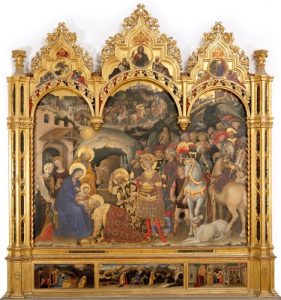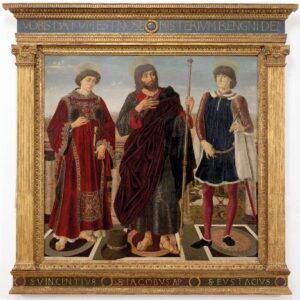Ciao from Italy! I’m currently on a multi-generational family trip. So what does this have to do with trademarks? Well, during a visit to the Uffizi Gallery in Florence, I stumbled upon a fascinating connection between Renaissance artwork and early examples of advertising and marketing.
Trademarks in Renaissance Art
Italian Renaissance painting was not merely focused on sacred themes. Many paintings were used as creative advertisements for the businesses of art patrons. Let’s look at two examples that showcase this unique blend of art and commerce.
 Commissioned by wealthy merchant Palla Strozzi, this painting served dual purposes. Along with its religious theme, Strozzi, depicted in the middle of the painting wearing red headgear and looking at the audience, used the painting to showcase and market the latest fabric styles he was selling.
Commissioned by wealthy merchant Palla Strozzi, this painting served dual purposes. Along with its religious theme, Strozzi, depicted in the middle of the painting wearing red headgear and looking at the audience, used the painting to showcase and market the latest fabric styles he was selling.
 At a time when people went to church multiple times a day, this piece acted as an innovative advertisement for his fabric business.
At a time when people went to church multiple times a day, this piece acted as an innovative advertisement for his fabric business.
 Here, another Florentine merchant commissioned this painting to display the fashionable attire he was selling. The saints were depicted wearing trendy clothing for men. The painting also includes a stylish hat, a must-have accessory for the in-crowd of the 1400s.
Here, another Florentine merchant commissioned this painting to display the fashionable attire he was selling. The saints were depicted wearing trendy clothing for men. The painting also includes a stylish hat, a must-have accessory for the in-crowd of the 1400s.
Product Placement: An Age-Old Marketing Tool
These Renaissance paintings reveal a timeless advertising technique that remains relevant today: product placement. This method provides significant advantages to trademark owners, including:
So the next time you’re enjoying a piece of art or watching your favorite show, keep an eye out for these subtle marketing techniques. You might discover a connection beyond the canvas or screen, just as I did in Florence.
Trust Tree Legal, P.C.
Mailing address:
798 Berry Road #41400
Nashville, TN 37204
Meetings by appointment only.
Attorney advertising.
Prior results do not guarantee a similar outcome.